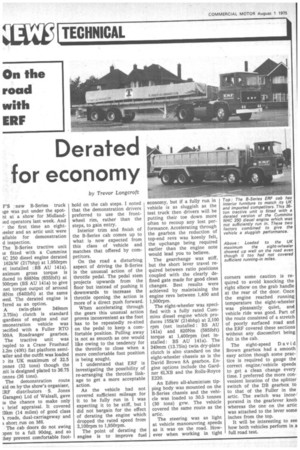D erated 1010-k .4,06.0
Page 20

If you've noticed an error in this article please click here to report it so we can fix it.
for economy
by Trevor Longcroft F'S new B-Series truck ige was put under the spotat at a show for Midland;ed operators last week. And • the first time an eightleeler and an artic unit were ailable for demonstration d inspection.
The B-Series tractive unit is fitted with a Cummins iC 250 diesel engine derated 162kW (217bhp) at 1,950rpm et installed :BS AU 141a). aximum gross torque is duced to 888Nm (6551bft) at 500rpm (BS AU 141a) to give net torque output of around ;8Nm (6401bft) at the same leed. The derated engine is fered as an option.
A twin-plate 349mm 3.75in) clutch is standard :gardless of engine and our ?.monstration vehicle was Jecified with a Fuller RTO 509A Roadranger gearbox. The tractive unit was )upled to a Crane Fruehauf ?..2m (401 t) flat platform semiailer and the outfit was loaded ) its UK maximum of 32.5 nines (32 tons) though the nit is designed plated to 36.75 )nnes (36 tons).
The demonstration route Lid on by the show's organiser, RF distributors • S. Jones larages) Ltd of Walsall, gave the chance to make only brief appraisal. It covered 3km (14 miles) of good class roads, dual-carriageway and short run on M6.
The cab doors do not swing ?en to a full 90deg, and so key prevent comfortable foot hold on the cab steps. I noted that the demonstration drivers preferred to use the frontwheel rim, rather than the steps, to gain entry.
Interior trim and finish of the B-Series cab comes up to what is now expected from this class of vehicle and matches that offered by competitors.
On the road a disturbing aspect of driving the B-Series is the unusual action of the throttle pedal. The pedal stem projects upwards from the floor but instead of pushing it downwards to increase the throttle opening the action is more of a direct push forward.
When accelerating through the gears this unusual action proves inconvenient as the foot has to be repeatedly re-sited on the pedal to keep a comfortable position. Pulling away is not as smooth as one would like owing to the tendency for the throttle to close when a more comfortable foot position is being sought.
I understand that ERF is investigating the possibility of re-arranging the throttle linkage to get a more acceptable action.
As the vehicle had not covered sufficient mileage for it to be fully run in I was expecting it to be stiff, but I did not bargain for the effect of derating the engine which dropped the rated speed from 2,100rpm to 1,950rpm.
The point of derating the engine is to improve fuel economy, but if a fully run in vehicle is as sluggish as the test truck then drivers will be putting their toe down more often to recoup any lost performance. Accelerating through the gearbox the reduction of top-end revs was keenly felt, the upchange being required earlier than the engine note would lead you to believe.
The gearchange was stiff, but the short lever travel required between ratio positions coupled with the clearly defined gate made for good clean changes. Best results were achieved by maintaining the engine revs between 1,400 and 1,90Orpm.
The eight-wheeler was specified with a fully rated Cummins diesel engine which produces 155kW (214bhp) at 2,100 rpm (net installed : BS AU 141a) and 820Nm (5851b1t) torque at 1,400rpm (net installed: BS AU 141a). The 349mm (13.75in) twin dry-plate clutch is also standard on the eight-wheeler chassis as is the David Brown 8A gearbox. Engine options include the Gardner 6LXB and the Rolls-Royce E220.
An Edbro all-aluminium tipping body was mounted on the B-Series chassis and the vehicle was loaded to 30.5 tonnes (30 tons) gvw. The vehicle covered the same route as the artic.
The steering was as light at vehicle manoeuvring speeds as it was on the road. However when working in tight corners some caution is required to avoid knocking the right elbow on the grab handle at the rear of the door. Once the engine reached running temperature the eight-wheeler was pleasantly quiet, and vehicle ride was good. Part of the route consisted of a stretch of poorly surfaced road and the ERF covered these sections without any discomfort being felt in the cab.
The eight-speed David Brown gearbox had a smooth easy action though some practice is required to gauge the correct engine/vehicle speeds to get a clean change every time. I preferred the more convenient location of the splitter switch of the DB gearbox to to that of the Fuller in the artic. The switch was incorporated in the gearlever knob whereas the one on the artic was attached to the lever some inches from the top.
It will be interesting to see how both vehicles perform in a full road test.




















































































